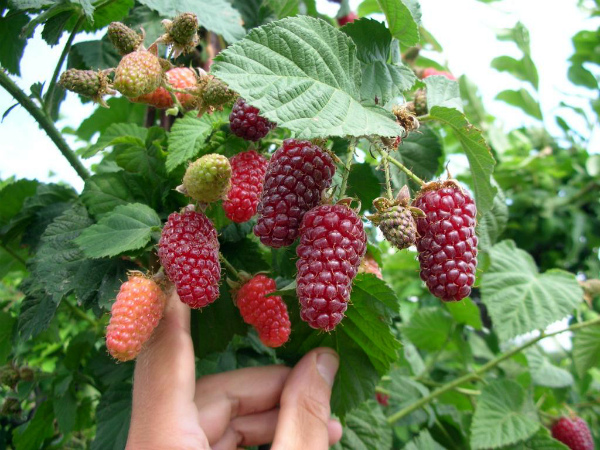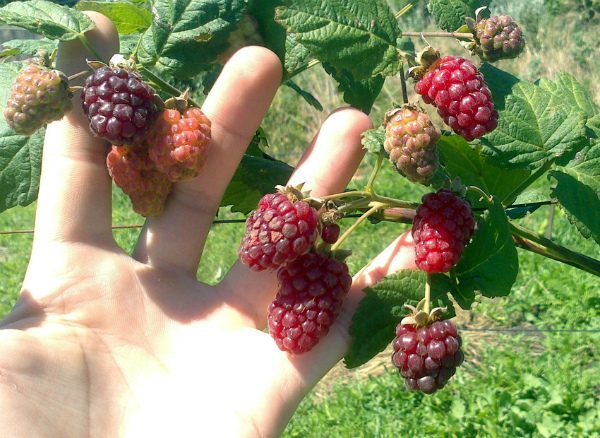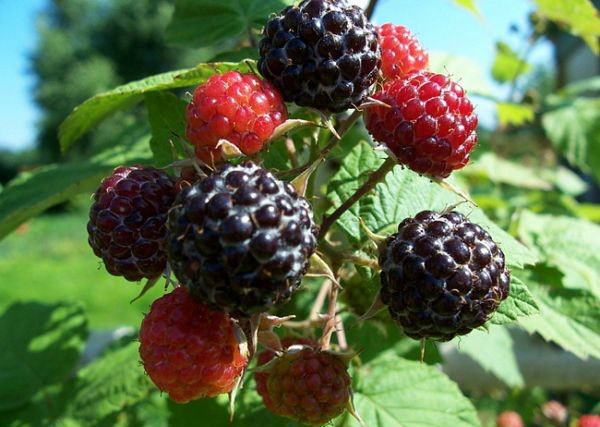Description of hybrids of blackberries with raspberries
Content
Characteristics and differences
Ezhemalina, and this is how the hybrid of these two related cultures is now called, received a mixture of the main characteristics of mother plants, which properties were more inherited, and it resembles that culture more strongly. There are many varieties of blackberries, raspberries and raspberries, all of which have their own differences. The breeders tried to combine the most beneficial and convenient properties of the two plants, and in many ways they succeeded. So a hybrid is often a semi-sprawling bush with shoots that first grow to a certain height straight up and then tilt down or grow parallel to the ground. They are incredibly decorative throughout the growing season - large white or pink flowers can favorably differ in the garden from the modest flowering of raspberries, berries (usually bright and not necessarily red) are collected in large brushes, their size speaks for itself.
Hybrids usually bear fruit later than garden raspberries and much longer. Their berries have a richer and more refined taste, they keep fresh longer, which allows them to be transported. The yield of raspberries, of course, loses in comparison with hybrids, they inherited this quality from blackberries. But raspberries gave them frost resistance, which blackberries obviously do not have.
Most hybrids do not produce root growth, which significantly reduces the time devoted to caring for them. But more importantly, they are resistant to certain fungal diseases that usually plague both raspberries and blackberries. So the varieties of Yangberry and Boysenberry are threatened by powdery mildew and verticillosis, while Loganberry is not at all susceptible to them. But Youngberry and Loganberry can develop rust, and Boysenberry has shown remarkable resistance to this very common disease. There are hybrids that are resistant to almost all fungal diseases.
Many varieties of ezhemalina have small thorns, and there are completely thornless ones, to the delight of gardeners. Unlike blackberries, they are drought-resistant, they tolerate the lack of watering more easily, since the root system penetrates much deeper into the soil.
Raspberry-blackberry hybrids
"Loganberry" is considered the very first hybrid of raspberries and blackberries. At the end of the 19th century, American breeder Logan was working on the development of new varieties of blackberries, and there was an accidental cross-pollination of his varieties with raspberries growing nearby. The result was a very fruitful and rather unpretentious variety in cultivation, but the taste of the berries left much to be desired.
This determined the direction of subsequent work, and today we have a creeping bush with more powerful shoots than raspberries. It does not give root suckers (if the roots are damaged, root shoots appear), the number of replacement shoots is small, but increases with age. Spiny shoots, grow more than 2 meters. Raspberry berries are elongated, the length reaches 4 cm, and the diameter is 2 cm, the average weight of the berry is 8 g, they have a pleasant taste with sourness and raspberry aroma. Ripens early, like regular raspberries.There are varieties (eg Thornless Loganberry) that do not have thorns, ripen in late summer and have a sweeter flavor.
Boysenberry, one of the most popular American hybrids, is a drought-resistant creeping shrub with large brownish-cherry round berries that, when fully ripe, become almost black, have a sweet and sour taste and a blackberry aroma. The yield is not very large for blackberries - up to 5 kg per adult bush, ripening occurs in July - August. There are spiked and spiked varieties.
In "Tayberry" powerful creeping shoots are painted in burgundy color as they ripen, they are covered with rare small thorns. The bushes are not at all demanding on the soil, they are very convenient for growing, since they are resistant to all known diseases, they tolerate drought well. Fruiting occurs in August, dark red berries weigh from 5 to 10 grams, sweet and sour with a pronounced blackberry flavor. Its closest relative, Tummelberry, is more frost-resistant, although our climatic conditions still require such plants to be sheltered for the winter.
"Sunberry" and "Youngberry" - late-ripening hybrids with thorns, dark red, darkening as they ripen, berries. Fruits can be harvested until the very frost, can serve as a true decoration of the garden, suitable for creating a hedge.
Michurinsky hybrid "Texas" gives 6 kg of tasty dark red berries from a bush, is productive for at least 15 years. Red berries are usually sweet and sour, and as they darken they become more and more sweet, the sourness almost disappears, only the blackberry aroma remains. He is not afraid of either harsh winters or cool rainy summers, long (up to 4 meters) creeping shoots grow and bear fruit perfectly in the Middle Lane. Among the disadvantages are sharp thorns and the fact that the berry does not separate from the stalk even when fully ripe.
Up to 10 kg of berries from one bush gives "Darrow", its berries are small, up to 4 g in weight, purple-red, sweet and sour. Its upright shoots reach 3 m, but the weight of the fruit can still bend them, so it is better to tie it to a trellis. This hybrid shows an amazing hardiness, but gardeners find its berries not the most delicious.
Today there are many varieties of ezhemalina, the difference between them is significant, which gives a great opportunity to choose. You can choose for every taste. The most important thing is that hybrids are unpretentious; the most inexperienced novice gardener can grow them. And the berry, although it differs in taste, size and color, is invariably useful for all varieties.
Video "Ezhemalina Tiberi"
Growing the Tybury variety is not difficult if you follow the advice of the author of this video.
Breeding hybrids
All hybrids show excellent seed germination, but not all seedlings grown from them retain the characteristics of the parent plant variety. Therefore, it is easier to plant ezhemalin cuttings or layering.
In the autumn (or summer) shortening of shoots, small sections of twigs with one or two buds are rooted in pots or directly in the garden (in spring and summer), and then transferred to a permanent place of growth in the spring. You can root lignified cuttings, they take root perfectly.
Young shoots can be dug in in the spring to a depth of 20 cm, pressing the shoot itself from above or with jokes, water this place all summer, and by autumn they will take root in several places, all that remains is to cut the shoot into several young plants, transplant. But it is better to transplant in the spring of next year, and before that time do not cut off the layers from the mother plant. To speed up this process, before burying the shoot under some buds, slightly scratch the bark, this will allow the roots to grow faster.
Sometimes gardeners divide the roots into root cuttings, and then plant them separately, from each such cuttings, if there is at least one root bud, a new plant will grow. To do this, in the spring, take roots 5–7 cm thick, cut them into pieces 10–15 cm long and plant them separately.
Advantages and disadvantages
Most hybrids are less whimsical and demanding in relation to the soil, watering and fertilization regime than pure varieties of raspberries and blackberries. Actually, this is what the breeders are trying to achieve - ease of cultivation, the advantages of fruiting. Therefore, over time, they become more and more popular, because resistance to fungal diseases, frost resistance, the ability not to lose crops during drought or too rainy summer are of great importance for cultivation.
The absence of thorns has become the undoubted advantage of many varieties of ezemalina. Such a traditional scourge for raspberries, such as a large amount of root growth, causes a lot of trouble for gardeners, and many hybrids are devoid of this drawback.
The size of the berries and the size of the harvest are of great importance. All hybrids are superior to raspberries in these indicators. An extended period of fruiting or its transfer to the end of summer and autumn is also in many ways more profitable than getting only a small harvest in June. Many hybrids made it possible to store and transport ripe berries for several days, which is important for summer residents, as well as for commercial cultivation.
Traditional disadvantages can be considered the presence of thorns, susceptibility (after all) to some diseases, insufficient frost resistance for our climate.
Most importantly, keep in mind that real seedlings of licensed varieties are very expensive, and you can often buy the wrong varieties from dishonest sellers.
Video "Ezhemalina Cumberland"
Take a look at the Cumberland Natural Raspberry / Blackberry Hybrid Review and learn about its characteristics, strengths and weaknesses.








